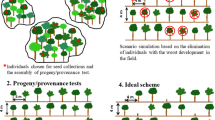Abstract
A model using integer quadratic mathematical programming has been developed to control the inbreeding level (or genetic diversity) through group coancestry in a selection programme for a forestry population structured in terms of maternal families coming from different locations. A method to calculate the average group coancestry between- and within-families for these open-pollinated populations is also proposed. This model has been applied to data from a breeding programme of Australian Eucalyptus globulus. The strategy proved to be effective as reductions of up to 50% for the group coancestry of the selected individuals were reached with a loss of only 5% of the maximum attainable selection differential (corresponding to truncation selection).
Similar content being viewed by others
Author information
Authors and Affiliations
Additional information
Received: 14 October 1999 / Accepted: 26 July 2000
Rights and permissions
About this article
Cite this article
Fernández, J., Toro, M. Controlling genetic variability by mathematical programming in a selection scheme on an open-pollinated population in Eucalyptus globulus. Theor Appl Genet 102, 1056–1064 (2001). https://doi.org/10.1007/s001220000444
Issue Date:
DOI: https://doi.org/10.1007/s001220000444




